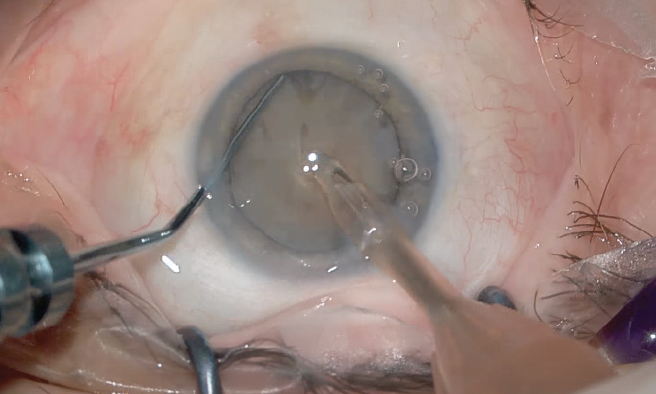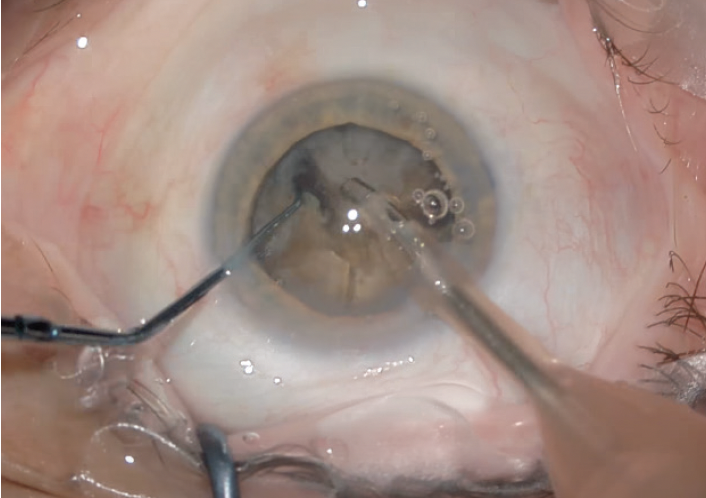My preferred technique of dividing or cracking a nucleus is horizontal chop,1 which I perform with an instrument I designed and some minor modifications depending on the density of the lens and the stability of the zonules.
MY TECHNIQUE
A 2.2-mm, single-plane, clear corneal incision is created, followed by two 1.1-mm sideport incisions. Next, a 5- to 5.2-mm continuous curvilinear capsulorhexis and gentle hydrodissection are performed.2 The tip of the chopper is passed under the edge of the capsulorhexis to engage the equator of the nucleus without using the phaco tip to lift it (Figure 1; see the video above to watch the technique),3 eliminating the need for a high vacuum level or aspiration flow rate to pull and lift the nucleus. Instead, the nucleus is divided by opposing the two instruments in the bag. This is the main difference between the technique as originally described by Nagahara1 and my modification.

Figure 1. The chopper slides under the edge of the capsulorhexis to engage the equator of the nucleus.
The advantages of my approach are that less aggressive fluidics may be employed and less stress is placed on the capsular bag complex (the bag itself plus the zonules of Zinn). With lower fluidic settings, the turnaround of balanced salt solution in the anterior chamber is kept to a minimum, which I find reduces endothelial trauma and results in less corneal edema on postoperative day 1. It can also lead to quicker visual recovery and a better refractive outcome.
TECHNOLOGY, SETTINGS, AND INSTRUMENTATION
Phaco units and settings. I normally use the Constellation Vision System or the Centurion Vision System with the Intrepid Balanced Tip (all products from Alcon). My preferred settings are a vacuum level of 280 mm Hg, an aspiration flow rate of 14 mL/min, 35% to 45% torsional ultrasound, zero longitudinal ultrasound, a dynamic rise of zero, and an irrigation bottle height of 105 cm (Constellation) or 50 cm (Centurion). I find the Balanced Tip provides good followability but less holding power than other phaco tips, which suits my technique of opposing the instruments without high vacuum.
I use similar settings if I must work with a longitudinal phaco unit. For a venturi pump such as the Stellaris (Bausch + Lomb), my preferred settings are a vacuum level of 280 to 300 mm Hg, 14% to 16% ultrasound, 15 to 20 pulses per second, and a 40:60 duty cycle. For a peristaltic pump such as the DORC Associate (DORC) or Visalis 100 (Carl Zeiss Meditec), my preferred settings are a vacuum level of 250 to 300 mm Hg, an aspiration flow rate of 24 mL/min, a rise time of 1.8 or fixed (DORC), and an ultrasound frequency of 40 kHz for soft and 20 kHz for hard nuclei.
Mishev F2F chopper. Performing the cracking maneuver in the bag can reduce stress on the zonules. I designed the Mishev F2F chopper (P-857, Epsilon; Figure 2) for this purpose.4 The instrument has two differently shaped surfaces. One acts like a wide oval spatula, and the other acts like a slicer. The tip is bent 85º vertically, and there is another distinct 45º bend at the end in the horizontal plane that helps the instrument reach under the capsule.

Figure 2. The design of the F2F chopper.
The slicing surface is used for cracking a hard nucleus. The spatula surface is useful for cracking a soft nucleus and for rotating nuclear pieces and epinucleus (see above to watch a surgical case in which the F2F was used).

Figure 3. Nuclear pieces are rotated with the spatula surface of the F2F chopper.
1. Nagahara K. Chop technique. Film presented at: ASCRS Annual Meeting; May 8-12, 1993; Seattle, WA.
2. Chang DF. Converting to phaco chop. Why? Which technique? How? Ophthalmic Practice. 1999;17(4):202-210.
3. Devgan U. Horizontal phaco chop for efficient cataract surgery. Cataract Coach. December 3, 2018. Accessed September 8, 2022. https://cataractcoach.com/2018/12/03/horizontal-phaco-chop-for-efficient-cataract-surgery/
4. Chang DF. Phaco Chop: Mastering Techniques, Optimizing Technology, and Avoiding Complications. Slack; 2004.




